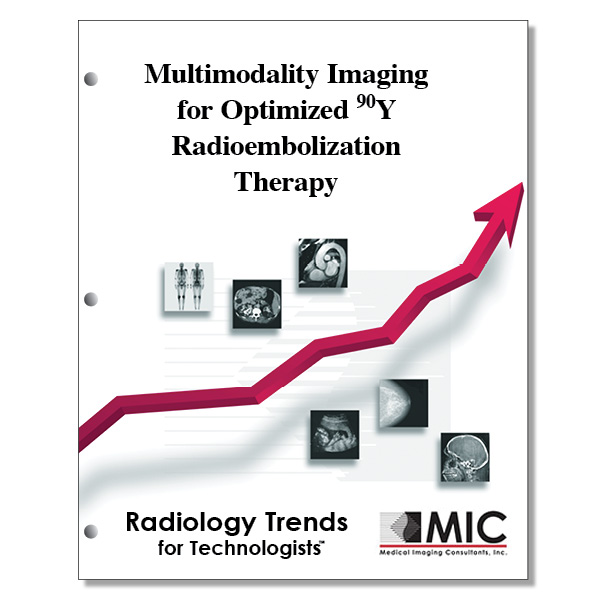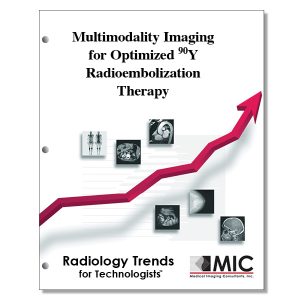

Multimodality Imaging for Optimized 90Y Radioembolization Therapy
A description of yttrium 90 radioembolization therapy for liver cancer including related multi-modality imaging strategies.
Course ID: Q00578 Category: Radiology Trends for Technologists Modalities: CT, Nuclear Medicine, PET, Radiation Therapy, Vascular Interventional2.5 |
Satisfaction Guarantee |
$29.00
- Targeted CE
- Outline
- Objectives
Targeted CE per ARRT’s Discipline, Category, and Subcategory classification for enrollments starting after December 10, 2024:
[Note: Discipline-specific Targeted CE credits may be less than the total Category A credits approved for this course.]
Nuclear Medicine Technology: 2.50
Procedures: 2.50
Radionuclides and Radiopharmaceuticals: 0.50
Endocrine and Oncology Procedures: 2.00
Registered Radiologist Assistant: 1.00
Procedures: 1.00
Abdominal Section: 1.00
Radiation Therapy: 1.00
Patient Care: 1.00
Patient and Medical Record Management: 1.00
Vascular-Interventional Radiography: 2.00
Procedures: 2.00
Vascular Interventional Procedures: 2.00
Outline
- Introduction
- General Principles of 90Y Radioembolization Therapy
- What is 90Y
- Vehicles Delivering 90Y: resin and Glass Microspheres
- Indications and Contraindications for 90Y Therapy
- Role of Imaging for 90Y Microsphere Therapy
- Preprocedural Cross-sectional Imaging and Patient Evaluation
- Combined Preprocedural Angiographic Vascular Mapping and 99mTc-MAA Shunt Examination
- 90Y Microsphere Dose Calculation
- Therapy Administration: Consolidation of Multidisciplinary Effort
- Postprocedural Bremsstrahlung Examination
- Multimodality Imaging Patterns: Classification to Improve Targeted Therapy
- Multimodality Imaging Approach
- Target 90Y Distribution: Complete and Incomplete Imaging Patterns
- Nontarget 90Y Distribution: Intrahepatic and Extrahepatic Imaging Patterns
- Conclusion
Objectives
Upon completion of this course, students will:
- describe what multidisciplinary preprocedural planning is required for a successful 90Y microspheres treatment
- explain the difference between glass based and resin based microspheres
- understand how 90Y induces cell death and the minimum absorbed dose required
- describe acceptable absorbed dose limits for normal liver and complications that can occur when these limits are exceeded
- describe how the specific activity of two different microspheres affect treatment dose
- list the FDA indications for 90Y radioembolization
- list the contraindications associated with microsphere radioembolization
- identify other important pre procedural information necessary for patient selection
- explain the rationale for utilizing 99mTcMAA prior to 90Y therapy
- recognize the importance for selective angiography of the superior mesenteric artery
- describe the considerations taken into account when imaging the left hepatic artery
- describe the physical characteristics of 99mTcMAA that allow it to be used as a preplanning surrogate for 90Y therapy
- list the technical parameters required for setting up a 99mTcMAA SPECT/CT acquisition
- explain how waiting too long after MAA injection can compromise imaging
- understand how the addition of SPECT/CT imaging can be of benefit for pretreatment planning
- explain how lung shunting impacts 90Y microsphere treatment
- describe the advantages associated with cone beam CT when used as an angiographic technique
- recognize the benefits of SPECT/CT fusion imaging with the incorporation of an advanced multimodality work station
- understand the dose calculation for glass based microspheres and the targeted dose range
- describe the methodologies employed to calculate resin based microsphere dose
- list the multiple safety procedures that are carried out on the day of therapy
- explain how SPECT/CT Bremsstrahlung imaging can be beneficial
- list the technical parameters required for a successful 90Y planar and SPECT/CT acquisition
- explain how 90Y PET imaging may be employed following therapy
- identify how PET/CT or SPECT/CT can categorize patients based on target and nontarget 90Y distributions
- list the common sites of nontarget extrahepatic activity
- list the options available to the radiologist during pre-therapy imaging to curtail incomplete lesion coverage and/or nontarget distribution
- describe what contributes to incomplete distribution of 90Y microspheres and potential corrective measures
- explain how substantial incomplete tumoral coverage contributes to a suboptimal 90Y therapeutic response
- describe intrahepatic vs extrahepatic nontarget embolization
- list potential corrective measures to reduce nontarget embolization
- explain how extrahepatic activity to the umbilical region may be difficult to identify
- describe a technical imaging maneuver on pre-therapy imaging that may prevent 90Y activity within the umbilical region
- explain why 90Y bremsstrahlung imaging can be clinically significant for those patients identified with extrahepatic activity
- explain how potential therapeutic complications can be mitigated through a multimodality approach
